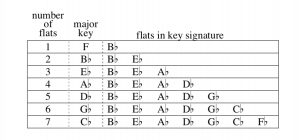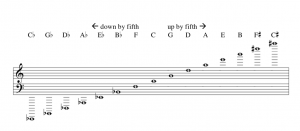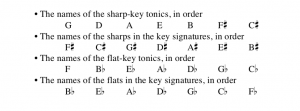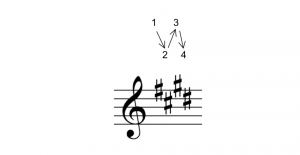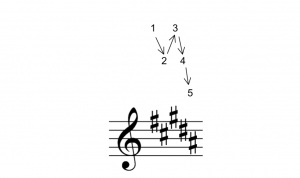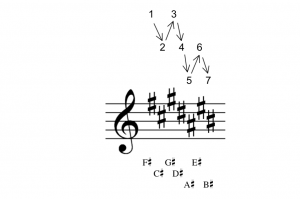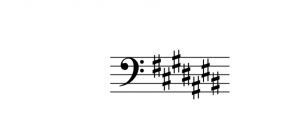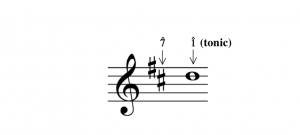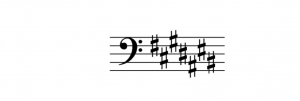The scales you wrote at the end of the last unit served several purposes. Through them, you developed skills in constructing whole and half steps, became more familiar with the sharp and flat symbols, and gained a more intimate knowledge of the structure of the major scale. But writing sharps or flats before every note of a piece of music becomes tedious and unnecessary. This unit shows you a more convenient way of altering pitches globally and systematically, through the system of key signatures.
The Simplicity and Convenience of Key Signatures
Look back to the scales you wrote at the end of the last unit, and consider using the notes of the F# major scale to notate “Frère Jacques” by writing a sharp before every note that needs one:
That works, but it’s cumbersome and unnecessarily repetitive. So let’s refer back to the F#-major scale:
We know just which notes will always be raised by a sharp in the key of F# major: F#, G#, A#, C#, D#, and E#. It is much more efficient to indicate this once at the beginning of each line of music, rather than to write a sharp before every note that needs one. We can place all of the sharps or flats from the key in a cluster at the beginning of each line, like this:
That group of sharps between the clef and the meter sign tells readers that every F, C, G, D, A, and E (regardless of octave) is to be raised by a half step. A group of sharps or flats applied globally at the beginning of a line of music is called a KEY SIGNATURE.
The System of Key Signatures
There’s a reason why those sharps are written in the special order shown above, and we’ll investigate that now. Refer back to the scales you wrote at the end of the previous unit. Notice that there is only one scale that has one sharp — the G major scale. And F# is that single sharp. We can place F# as the key signature for G major before the scale:
Return to your list of scales, and find the scale with two sharps. There is only one — D major. Its two sharps are F# and C#. In the key signature, we’ll leave the F# as the first sharp, and add C# as the second sharp after it:
This process continues as sharps are added one by one. Here’s a table that shows how the keys and the sharps correspond:
The sharps are always written on the treble and bass clef staves like this:
You must memorize the exact placement of the sharps on each staff. You must learn the order of the sharps, and the order (in terms of number of sharps) of the keys they represent.
This very same process works with the flats as well:
And the flats are always written on the treble and bass clef staves like this:
You must also memorize the exact placement of the flats on the staves, their order, and the order of the keys they represent.
Key Signatures and the Tonic
As we learned in the previous unit, when we move the tonic to a new pitch, we say that we are in the key of that new pitch. For example, if we move the tonic to G, we say we are in the key of G major. The sharps or flats in a key signature rearrange the positions of the whole and half steps in the staff in order to move the tonic. For example, the one-sharp signature places the half steps at B–C and F#–G, moving the tonic for the major scale to G. For now — while we’re only working with major keys — seeing a key signature will automatically tell you where the tonic has been moved. In the sharp keys, as we add each new sharp to a key signature the tonic moves up a fifth. In the flat keys, as we add each new flat to a key signature the tonic moves down a fifth. In this way, adding a sharp has the same effect as subtracting a flat, and vice versa. We can therefore arrange the tonics of the keys in a succession of fifths, with C major (the key with no sharps or flats) in the middle, and progressing upwards by fifth (to the right in the figure below) through the sharp keys, and downwards by fifth (to the left in the figure below) through the flat keys:
Notice that the three keys with the most flats (Cb, Gb, and Db) are enharmonic with the three keys with the most sharps (B# F#, and C#). Each of these enharmonic pairs comprises two different ways of spelling the same pitch on the piano keyboard. For example, the same black key serves as the tonic for both Gb major and F# major.
Because these enharmonic keys overlap, we can rearrange the keys from a straight line (as in the figure above) into a spiral, with the pairs of enharmonic keys overlapping:
In this representation, the key of C major is at the top of the spiral. From there, the sharp keys progress clockwise around the spiral, and the flat keys progress counterclockwise. The keys are arranged by increasing number of sharps or flats. Each tonic is written as a whole note on the staff after the key signature. The ends of the spiral overlap where three sharp keys overlapping three flat ones. Therefore, although there are fifteen unique note names for keys, are only twelve enharmonically unique keys (three of the fifteen are duplicated by enharmonic equivalents). Although enharmonic keys sound alike, they present vastly different challenges in music reading and writing. For example, reading or writing a melody in the key of C# major and Db major involve pitches with completely separate note names and positions on the staff. Another consequence of overlapping enharmonic keys is that the figure above can be seen as continuous — a circle of twelve keys. This figure is referred to a the CIRCLE OF FIFTHS, because the keys progress around the circle by the interval of a fifth.
Key Signatures and Scale Degrees
One of the effects of key signatures is that they move all scale degrees to new pitches. For example, consider the following hymn tune and its associated scale degree syllables in C major:
If we were to move this melody up to the key of E major, the new key signature moves all of the scale degrees to new pitches as follows:
The four-sharp signature represents E major. This means that 1 has been moved to the pitch E. All the other scale degrees move to new locations in relation to 1. Scale degrees involve the functions of the pitches in the prevailing key. When the prevailing key changes, the functional label of any given pitch will change. For example, consider the pitch B. In C major its label is 7, but in E major its label is 5. It takes on a different label because of its different function (and feeling) in each key . In this way, there are two systems for labeling pitches: (1) a fixed method, using letter names to represent absolute pitches (C, Bb, etc.); and (2) a functional method, using numbers to represent the scale degrees of pitches within a key (2, 4, etc.). When reading music in various major keys, your first step should be to determine where ! is placed by the key signature. All other pitch relationships spring from this tonal center. It takes time and practice to learn to read the syllables in each key and clef, but this is an essential aspect of tonal music.
The pitches created by any given key signature (including its sharp or flat and natural notes) are called DIATONIC pitches. All the diatonic pitches from a given key signature taken together form a DIATONIC COLLECTION.
Tips for Writing Key Signatures
You must learn to write the key signature for any major key without hesitation. To do this, you’ll first need to memorize four things (as we discussed in “The System of Key Signatures,” above):
Next, you’ll need to memorize the exact placement of the sharps and flats in both treble- and bass-clef staves.
Sharp Keys. We’ll start with sharps in the treble clef. We place the first sharp (F#) on the fifth line of the staff. The first four sharps form an up-down-up-down pattern, like this:
But the fifth sharp (A#) can’t continue this pattern without the use of a ledger line, so musicians instead place it down in the staff, creating an up-down-updown-down pattern:
This gives the key signature for B major (and the keys that follow it) a characteristic shape that musicians recognize.
The next sharp (E#) can be placed higher, but the last sharp (B#) must also be placed lower, which creates a down-up-down pattern for the last three sharps:
In the bass clef, key signatures follow the same shape as in the treble clef, but — of course — on the appropriate lines and spaces, starting with fourth-line F#. Although A# and B# could fit without ledger lines, musicians use the same altered arrangement of sharps as in the treble clef so that the shape will be consistent and recognizable:
Flat Keys. The flats follow a consistent down-up-down-up-down-up-down pattern in both clefs, without alteration:
When you write key signatures, make certain that each sharp and flat occupies its own horizontal space and that neither sharp or flat on either side encroaches on it.
Tips for Identifying Key Signatures Sharp Keys.
Sharp Keys. The last sharp in each key signature represents 7 in the major scale. For example, in the key signature for D major the last sharp is C#. This is 7 (the leading tone) of D (the tonic):
In using this shortcut, you must be careful always to treat the last sharp as a sharp and to count up exactly one half step to the next letter name. For example, in the following key signature the last sharp is B# (not B or C) and the tonic is C# (not C or Db):
Flat Keys. The last flat in each key signature represents 4 in the major scale. For example, consider the key signature for Bb major:
You can count down a fourth from last flat, Eb, to the tonic, Bb. You must be careful to accurately count down a fourth (remembering that musical intervals are numbered by the number of letter names they span) and to observe that the tonic is already lowered by a flat (in this case the tonic is Bb, not B).
Fortunately, there is an even easier shortcut: In every major key signature with two or more flats, the tonic is the next-to-last flat in the signature. For example, in the following key signature the next-to-last flat is Db; therefore, this key signature represents Db major:
The only flat key for which this shortcut doesn’t work is F major, which has only one flat. Memorize the one-flat signature for F-major, and you can calculate the rest of the flat keys by looking to the next-to-last flat in the signature for the tonic.
Accidentals
Sometimes, it’s necessary to raise or lower a note from what’s given by the key signature. For example, in the following excerpt the composer lowers B in m. 45 by a half step to Bb in m. 46, then raises what would be D by a half step to D# at the end of m. 48. These changes are notated by placing the sharp or flat immediately before the note on the staff.
Note that in writing or speaking in words about music, we say the letter name of the note followed by the accidental — for example, we write “Bb” and say “B-flat.” But in notating music we place the accidental before the note. In some cases, we need to cancel a sharp or flat, returning a note to its natural state. In such cases, we place the symbol IMG (called a NATURAL) immediately before the note, as in m. 4 of the following excerpt.
Any sharp, flat, or natural placed immediately before a note is called an ACCIDENTAL.
In some rare instances, musicians need to lower or raise a note by two half steps. In such cases, we use a DOUBLE FLAT (bb) to lower a note two half steps or a DOUBLE SHARP (##) to raise a note two half steps. A double flat appears in m. 13 of the following excerpt.
And a double sharp appears in m. 3 of the following excerpt.
Accidentals “carry over” within a measure — that is, they apply to the all subsequent notes on the same line or space for the rest of the measure in which they appear (unless they are “cancelled” by some subsequent accidental). This lasts only until the end of the measure; the bar line cancels the effect of all accidentals. So, for example, in m. 3 of the excerpt immediately above, the first note is F# (the sharp applying from the key signature), and the next two notes are F## (with the double sharp carrying over from the second to the third note in the measure).







